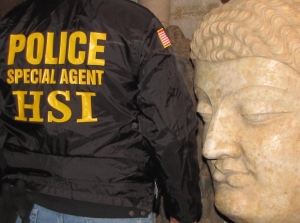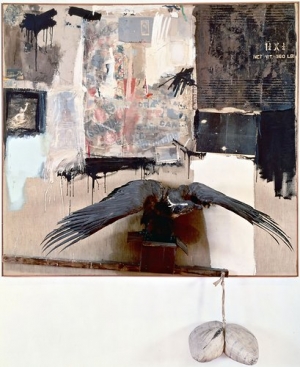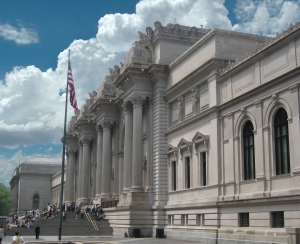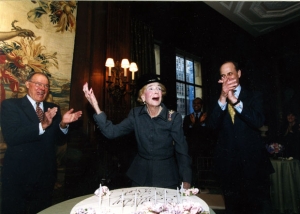|
Displaying items by tag: Metropolitan Museum of Art

Mary Griggs Burke, who built the most comprehensive collection of Japanese art outside of Japan, passed away on December 8, 2012 at her home in Manhattan. She was 96.
Burke’s collection, which she amassed over fifty years, featured thousands of artifacts including paintings, prints, sculpture, textiles, lacquerware, ceramics, and calligraphy. Worth tens of millions of dollars, her meticulously assembled collection spans five millenniums and includes early pieces from around 3000 B.C. to works of the 19th century A.D.
Burke was born in St. Paul, Minnesota in 1916, where she grew up in a Victorian mansion adorned with 18th century French objets d’art as well as a few important Japanese artifacts. After earning a bachelor’s degree in 1938 from Sarah Lawrence College and a master’s in clinical psychology from Columbia, Burke traveled to Japan in 1954. Japanese-influenced Bauhaus architect, Walter Gropius, who was designing a house for Burke, suggested the visit. Burke immediately fell in love with Japan and its art and returned to the country dozens of times throughout her life.
Burke began avidly collecting Japanese art in 1963. Her holdings eventually grew so vast that they required their own residence. Burke purchased the apartment adjacent to her own on the Upper East Side of Manhattan to house her collection; she also employed a curatorial staff and encouraged students and scholars to visit. In 2006, Burke announced that after her death her collection would be divided between the Metropolitan Museum of Art in New York and the Minneapolis Institute of Art. Burke served on the boards of many institutions, including the Met. At the time of her death she was an emeritus trustee of the museum.

British art collector, Douglas A.J. Latchford, has spent decades building his reputation as one of the foremost experts in Khmer antiquities. Latchford, a resident of Thailand, was knighted in 2008 by the Cambodian government for admirably returning 14th-century Khmer artifacts.
In sharp contrast to his previous accolades, Latchford is currently the subject of a civil complaint files by the U.S. attorney’s office. Federal lawyers state that Latchford, referred to in proceedings as “the Collector,” bought a 10th century Khmer warrior statue known as the Duryodhana in the 1970s knowing that it had been looted from a temple during the Cambodian civil war.
While Latchford denies ever having owned the work, court papers claim that he purchased the statue from a Thai dealer who acquired the work from an organized looting network. Allegedly, Latchford then helped get the piece into Britain by concealing what was actually being shipped. Upon its arrival to the U.K., the auction house Spink & Son sold the statue to a Belgian collector in 1975. The collector’s widow is the Duryodhana’s current owner.
The widow approached Sotheby’s New York in 2010, hoping to sell the 500-pound sandstone statue. However, the sale was put on hold because of objections from the Cambodian government. While lawyers are hoping to return the work to Cambodia, the auction house still plans on selling the treasure, stating that there is no evidence to prove that the statue was looted or that it is the property of the Cambodian government.
Latchford has been collecting Cambodian antiquities for over 55 years and has donated many works to well-known institutions, including the National Museum in Phnom Penh and the Metropolitan Museum of Art. A judge is expected to rule on the Duryodhana case within the next few months.

Thomas Hart Benton’s (1889-1975) epic mural, America Today (1930-31) has found a new home at New York’s Metropolitan Museum of Art. A sweeping panorama of American life, the work once lined a boardroom at the International-Style New School for Social Research on West 12th Street, which was designed by the Austrian architect, Joseph Urban (1872-1933).
The 10-panel mural, which was Benton’s first major commission, ushered in a new approach to mural painting, turning to the reality of everyday life for inspiration. America Today portrays American life prior to the Great Depression and features the flappers, farmers, steel workers, and stock market moguls that are readily associated with the period. The mural remains Benton’s best-known work and a masterpiece of modern art.
Benton, an American realist painter, drew inspiration for the mural from his travels around the United States in the 1920s. A glimpse into both rural and urban life at the time, America Today portrays the wealthy and poor as well as the progressive and traditional ideals that defined the era. While Benton did not receive a fee for the commission, the work opened the door for future commissions and helped inspire the Works Progress Administration mural programs that were implemented in the late 1930s.
Bought by the insurance company, AXA Equitable, nearly 30 years ago, America Today was in storage before the decision to donate the work was made. However, the Met is currently without extra exhibition space and the mural won’t be on view until at least 2015 when the museum takes over the Whitney Museum of American Art’s Marcel Breuer building on Madison Avenue. The Whitney is headed to its own larger space in the meatpacking district. America Today is the first artwork that Met officials have confirmed for the Breuer building.

Subhash Kapoor, a once-established antiquities dealer in New York, has been the source of much controversy over the past few months. In July, authorities asked American museums to search their collections for any works obtained from Kapoor after it was revealed that he was in possession of looted antiquities. Allegedly, Kapoor has trafficked more than $100 million worth of stolen Indian artifacts and on December 5, authorities added to his list of thefts after a raid at the Port of Newark.
U.S. Immigration and Customs Enforcement agents with Homeland Security Investigations teamed up with Indian authorities and the Manhattan District Attorney’s office and seized more than $5 million worth of artifacts including a 14th century statue of the Hindu deity, Parvati, and four bronze figures from India’s Tamil Nadu region. It is believed that all of the works were stolen from Indian temples. The The Parvati statue has been in the possession of six different dealers and is marred by a litany of false provenances despite being listed on an Interpol database of stolen artworks.
Kapoor ran the Art of the Past Gallery on Madison Avenue from 1974 until his arrest last July. He has donated and sold antiquities to many distinguished institutions including the Metropolitan Museum of Art. Kapoor is currently facing criminal charges in India.

One of the most significant artists of the 20th century, Henri Matisse (1869–1954) is best known for his use of color and fluid, innovative forms. A leading figure in modern art, the French artist defined the Fauvist movement, but defied classification. The works of Nicolas Poussin, Édouard Manet, Auguste Rodin, Paul Gauguin, Paul Cézanne, and Jean-Baptiste-Siméon Chardin inspired Matisse and he communed with groundbreaking artists such as Camille Pissarro, André Derain, and Gertrude Stein.
The Metropolitan Museum of Art’s exhibition Matisse: In Search of Painting opens on December 4 and explores the evolution of Matisse as a painter. Matisse worked rigorously, often painting the same scene and subject over and over again to gauge his own progress and compare various techniques, a process he developed during his academic training.
In Search of Painting features just 49 vibrant canvases but spans Matisse’s entire career. Organized by Rebecca Rabinow, a curator of modern and contemporary art, the exhibition places the works in pairs and groups by subject to illustrate Matisse’s methodical process. In the 1930s, Matisse began having photographs taken at various stages of each painting to document their evolution. Three of the finished canvases along with their accompanying photographs will also be on view. The juxtaposition illustrates Matisse’s own self-awareness and the arduous process that led to each finished canvas.
Matisse: In Search of Painting will be on view through March 17, 2013.

The children of the New York art dealer, Ileana Sonnabend, have donated Robert Rauschenberg’s mixed media assemblage, Canyon (1959), to the Museum of Modern Art in New York. While the acquisition is a welcomed addition to MoMA’s existing Rauschenberg collection, the work wasn’t always so warmly regarded.
The Sonnabend heirs received Canyon after their mother’s death in 2007 and the work was soon at the center of a battle between MoMA and the Metropolitan Museum of Art, where the piece had been displayed intermittently since 2005. MoMA ramped up its efforts and promised to add Ms. Sonnabend’s name to the Founders Wall in the museum’s lobby. Officials also vowed to mount an entire show devoted to Canyon as well as Sonnabend, an important player in the modern art movement. While the Met made offers of their own, the Sonnabend family ultimately decided that MoMA was the right home for the work considering the expansive Rauschenberg collection already in the institution’s possession.
Sadly, this is not the first dramatic episode Canyon has been involved in. When the Sonnabend children inherited the work five years ago, appraisers valued the assemblage at $0. The presence of a stuffed bald eagle, a bird that is protected by federal laws, halted any possible sales of trades involving the work. The I.R.S., on the other hand, shrugged this off and claimed that Canyon was worth $65 million and demanded that Sonnabend’s family pay $29.2 million in taxes and another $11.7 million in penalties.
Eventually, a settlement was worked out and I.R.S. dropped all tax charges. In order for this to happen, the Sonnabends were required to donate Canyon to a museum where it could be put on public display. Canyon will be on view at MoMA beginning today, November 28.
Two members of the Metropolitan Museum of Art in New York are suing the institution for deceiving the public by making patrons think that the suggested admission fees are mandatory. The historically free institution suggests entry fees of $25 for adults and less for seniors and students.
Theodore Grunewald and Patricia Nicholson files the suit in state court in Manhattan and said that the museum’s fee policy lacks transparency. They also argued that and that the museum fails to note that the fee is suggested on several of its websites and that it’s only in fine and barely legible print on signs near cash registers. A statute was put in place in 1893 declaring that the Met must remain free in order to continue receiving government funding.
Grunewald and Nicholson commissioned a survey of visitors to the museum and found that 85% of patrons believed they had to pay to gain entry.

Xavier Salomon, a curator in The Metropolitan Museum of Art’s European paintings department, announced that the institution has acquired The Penitent Saint Peter by Jusepe de Ribera. The early work by the 17th-century painter is the first Spanish painting purchased by the museum in over 40 years. One of the Met’s most esteemed artworks, Diego Velazquez’s portrait, Juan de Pareja (1650), had been the most recent Spanish acquisition.
The painting by Ribera is a full-length portrait of St. Peter from 1612-13, when the artist was in his early 20s. Up until about 10 years ago when the Italian scholar Gianni Papi realized that a group of paintings once attributed to an anonymous artist were in fact Ribera’s, none of the artist’s early works were known. Juan de Pareja wasn’t identified as a Ribera painting until last year.
Purchased from Madrid dealers Coll & Cortes, this is the second work by Ribera in the Met’s permanent collection. Officials declined to say what they paid for the painting, but experts value the work at around $1.3 million. The other Ribera painting in the museum’s collection is a late work from 1648, four years before the artist’s death, titled The Holy Family with Saints Anne and Catherine of Alexandria.

While a lot of time, thought, and care goes into the creation of exhibition catalogues, their lifespans tends to be short-lived. Unhappy with this accepted cycle, Thomas P. Campbell, director of the Metropolitan Museum of Art, decided to change things. The Museum’s new online resource, MetPublications, allows users to browse more than 600 catalogues, journals, and museum bulletins, including 368 out-of-print publications. It will even be possible to get copies of 140 of those out-of-print catalogues along with paperbound editions with digitally printed color reproductions through Yale University Press.
Spanning from 1964 to the present, topics covered include art, art history, archaeology, conservation, and collecting. MetPublications includes a description and table of contents for almost all of the periodicals and even offers information about the authors, reviews of the books, and links to related publications and art in the museum’s collection. The comprehensive resource will also provide links to purchase in-print books. If a reader is in need of a book but is not close to the museum or the book is not in the Museum’s holdings, MetPublications will direct them to WorldCat, a global library catalogue. Over time, the Met plans to add publications dating as far back as 1870, when then the museum was founded.
While other museums such as the Solomon R. Guggenheim Museum and the Los Angeles County of Museum of Art already have scholarly resources online, it is a welcome addition to the Met’s offerings.

Before her death in 2007, Brooke Astor was a fixture in New York City’s elite inner circle. A tireless philanthropist and champion of the arts, Astor left behind a legacy marked by kindness, generosity, and good taste.
Sotheby’s has announced an auction of the contents of two of Astor’s estates – her legendary Park Avenue duplex and her country estate, Holly Hill, in Briarcliff Manor, NY. A total of 901 items including European and Asian furnishings, Old Master paintings, Qing Dynasty paintings, tea sets, silverware, jewelry, a porcelain menagerie, and over 100 dog paintings will head to the auction block September 24–25. Per Astor’s request, proceeds from the sale will go to the institutions and causes she held dear including the New York Public Library, the Metropolitan Museum of Art, the Bronx Zoo, Central Park, the Animal Medical Center of New York, New York City’s public school system, and a number of charities in Maine. Sotheby’s expects the sale to bring in between $6 and $9 million for the entire collection.
An icon of New York society and refinement, Astor spent her final years suffering from dementia. After her death at 105, her estate remained in limbo due a family dispute that lasted five years. The feud ended in March of 2012 and $100 million of Astor’s estate was freed for her charities. The amount going to Anthony Marshall, her only son, was cut by more than half as he was convicted of taking advantage of his mother’s deteriorating mental state and altering her will to his advantage.
Among the most coveted of Astor’s pieces that will be headed to Sotheby’s are an Imperial Chinese gilt-bronze lion clock slated to bring in around $180,000–$220,000 and an emerald and diamond necklace with earrings estimated at $280,000– $390,000 for both.
|
|
|
|
|